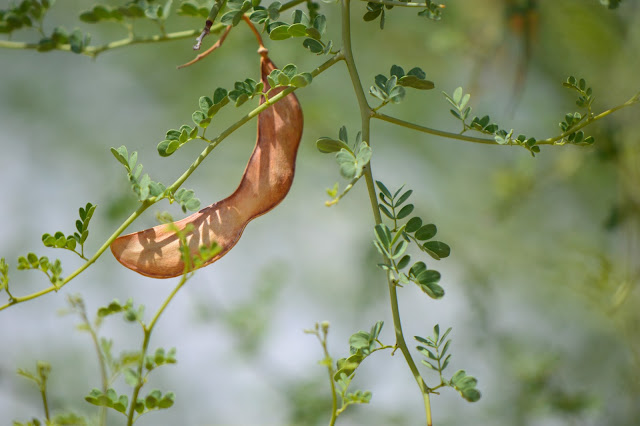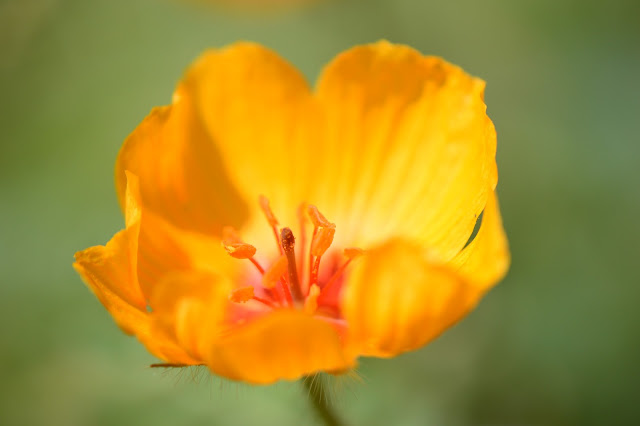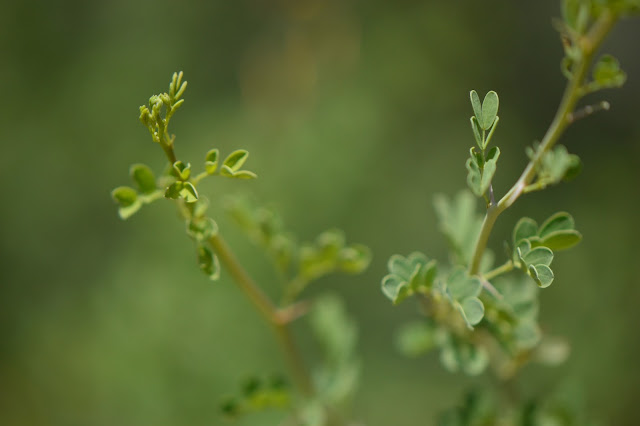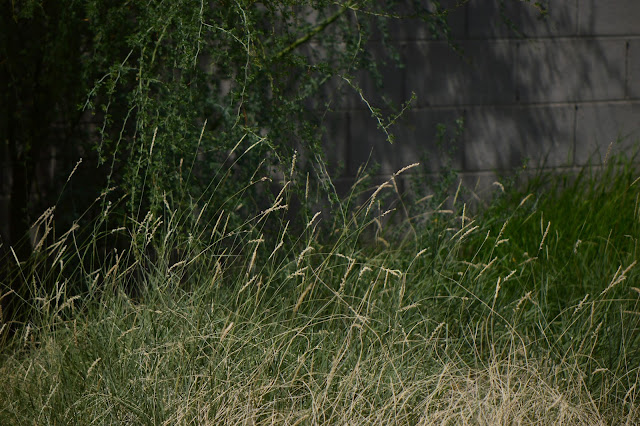Today's walk to see the wild tree proved to be a voyage of discovery. The few rains we have had during July have altered the landscape in many ways.
The first surprise was finding a couple of blooms of Desert Poppy open... at last! These marvelous wildflowers (Kallstroemia grandiflora, see my post from last year) are not true poppies despite the name; they are not even related to the California or Mexican Poppies (Eschscholzia spp.). Rather they are distantly akin to the common Arizona shrub Larrea tridentata (Creosote). But their brilliant golden blooms are rather poppy-like and serve a similar purpose, bursting into colour over the desert landscape during the monsoon season.
The humble Chinch Weed (Pectis papposa) is also beginning to carpet the ground.
As I went on, I came to a large shrub which stands near the Palo Verdes. I haven't shown any pictures of it before, which is too bad as the difference between last month and this is astounding. At the beginning of July it was entirely leafless, nothing but an intimidating, tangled, grey mass of thorns. Now? It is fully leafed out. I have yet to identify this plant. It bears little red fruits later in the year if I remember rightly.
Its thorns remain impressive!
On up to the much gentler cluster of Palo Verde trees (Parkinsonia florida) which I am watching for Tree Following, the wonderful meme with Lucy at Loose and Leafy . These trees, too, have changed rapidly with the rains. Branches which were nearly bare one month ago are clad in an abundance of tiny leaves.
The whole little group once more has a full canopy of foliage...
...reaching to the sky.
Branch tips are delicate with tiny clusters of new leaves.
And the green bark is brilliant in the sunshine.
Only a very few seedpods are left.
Next to the trees are some patches of wild grass, which make a miniscule meadow. I love their plumes.
Also nearby are many bushes of the aforementioned Creosote (Larrea tridentata). Bright yellow flowers are out in response to the rain.
And lastly, the walk inevitably directed itself toward the magnificent blooms on the wild Ferocactus emoryi(?). Today they were a haven for bees, but that was another adventure!
Weather Diary: Partly cloudy; High: 104 F (40 C)/Low: 90 F (32 C)














The seed pods on the Palo Verde tree look like a bean, is it a legume.
ReplyDeleteThe bees seem to be enjoying their colourful feed.
It is indeed a legume, and the pods are said to be edible. I'm learning that many of the best-adapted desert trees are members of the legume family, including the Palo Verdes, Mesquites (Prosopis), Desert Willows (Chilopsis), and Acacias.
DeleteYes, the bees were very happy :)
Big thorns and little red fruits. Possibly a Lycium, maybe andersoni or brevipes.
ReplyDeleteA big thank you, Jane! Very possibly Lycium andersoni or possibly L. torreyi, though in both cases the leaves look more fleshy than I recall with this plant. I'll have to take another look ;-)
DeleteWhat a difference the rain makes Amy. It's nice to see your trees now dressed in their finery! Was going to mention the seed pod resembling a pea pod but see Brian beat me to it.
ReplyDeleteI am in awe of the shot with the bees - well captured!
The bees kept burrowing deep inside those stames, totally disappearing and then popping back out. I never could catch that 'pop' moment, but I had plenty of chances for other shots! Aren't those Palo Verde pods wonderful? I've read other species' taste better, but these are fully edible...
DeleteWhen I first got into botany, in California, I was so impressed by the quick response of desert plants to moisture – from annuals to trees. So I really enjoyed this tour :-)
ReplyDeleteI watched the wild plants last summer (our first in Arizona) but still didn't realize just how fast the changes occur! It's wonderful, isn't it? Thanks a lot, Hollis :)
DeleteI love that bee pic!
ReplyDeleteThank you, Kris :)
DeleteBee shot is fantastic! So interesting to learn about such an extreme environment, so alien to me, here in the uk, where the one thing we can guarantee is RAIN!!
ReplyDeleteThank you, Jane! It's quite an experience learning to factor in the more extreme elements here, I must admit.
Delete